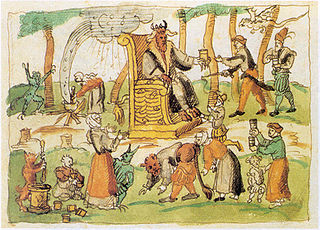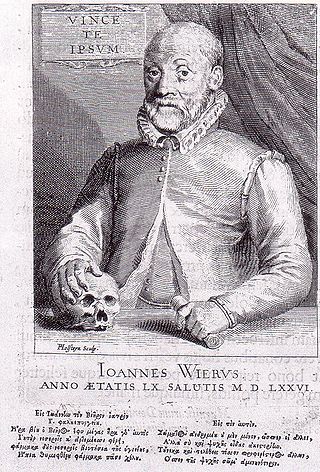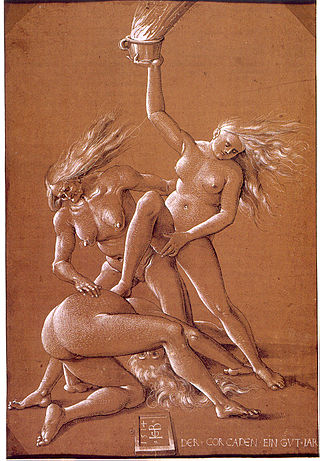Related Research Articles

The Inquisition was a group of institutions within the Catholic Church whose aim was to combat heresy, conducting trials of suspected heretics. Studies of the records have found that the overwhelming majority of sentences consisted of penances, but convictions of unrepentant heresy were handed over to the secular courts, which generally resulted in execution or life imprisonment. The Inquisition had its start in the 12th-century Kingdom of France, with the aim of combating religious deviation, particularly among the Cathars and the Waldensians. The inquisitorial courts from this time until the mid-15th century are together known as the Medieval Inquisition. Other groups investigated during the Medieval Inquisition, which primarily took place in France and Italy, include the Spiritual Franciscans, the Hussites, and the Beguines. Beginning in the 1250s, inquisitors were generally chosen from members of the Dominican Order, replacing the earlier practice of using local clergy as judges.

The Malleus Maleficarum, usually translated as the Hammer of Witches, is the best known treatise purporting to be about witchcraft. It was written by the German Catholic clergyman Heinrich Kramer and first published in the German city of Speyer in 1486. Some describe it as the compendium of literature in demonology of the 15th century. Kramer blamed women for his own lust, and presented his views as the Church's position. The book was condemned by top theologians of the Inquisition at the Faculty of Cologne for recommending unethical and illegal procedures, and for being inconsistent with Catholic doctrines of demonology.
The Roman Inquisition, formally Suprema Congregatio Sanctae Romanae et Universalis Inquisitionis, was a system of partisan tribunals developed by the Holy See of the Catholic Church, during the second half of the 16th century, responsible for prosecuting individuals accused of a wide array of crimes according to Catholic law and doctrine, relating to Catholic religious life or alternative religious or secular beliefs. It was established in 1542 by the leader of the Catholic Church, Pope Paul III. In the period after the Medieval Inquisition, it was one of three different manifestations of the wider Catholic Inquisition, the other two being the Spanish Inquisition and Portuguese Inquisition.

A witch-hunt, or a witch purge, is a search for people who have been labeled witches or a search for evidence of witchcraft. Practicing evil spells or incantations was proscribed and punishable in early human civilizations in the Middle East. In medieval Europe, witch-hunts often arose in connection to charges of heresy from Christianity. An intensive period of witch-hunts occurring in Early Modern Europe and to a smaller extent Colonial America, took place about 1450 to 1750, spanning the upheavals of the Counter Reformation and the Thirty Years' War, resulting in an estimated 35,000 to 50,000 executions. The last executions of people convicted as witches in Europe took place in the 18th century. In other regions, like Africa and Asia, contemporary witch-hunts have been reported from sub-Saharan Africa and Papua New Guinea, and official legislation against witchcraft is still found in Saudi Arabia and Cameroon today.

Heinrich Kramer, also known under the Latinized name Henricus Institor, was a German churchman and inquisitor. With his widely distributed book Malleus Maleficarum (1487), which describes witchcraft and endorses detailed processes for the extermination of witches, he was instrumental in establishing the period of witch trials in the early modern period.

Jacob Sprenger was a Dominican inquisitor and theologian principally known for his association with a well-known guide for witch-hunters from 1486, Malleus Maleficarum. He was born in Rheinfelden, Further Austria, taught at the University of Cologne, and died in 1495 in Strasbourg.

A Witches' Sabbath is a purported gathering of those believed to practice witchcraft and other rituals. The phrase became especially popular in the 20th century.
Summis desiderantes affectibus, sometimes abbreviated to Summis desiderantes was a papal bull regarding witchcraft issued by Pope Innocent VIII on 5 December 1484.

The Directorium Inquisitorum is Nicholas Eymerich's most prominent and enduring work, written in Latin and consisting of approximately 800 pages, which he had composed as early as 1376. Eymerich had written an earlier treatise on sorcery, perhaps as early as 1359, which he extensively reworked into the Directorium Inqusitorum. In compiling the book, Eymerich used many of the magic texts he had previously confiscated from accused sorcerers. It can also be considered as an assessment of a century and a half of official Inquisition in the "albigensian" country.

The title canon Episcopi is conventionally given to a certain passage found in medieval canon law. The text possibly originates in an early 10th-century penitential, recorded by Regino of Prüm; it was included in Gratian's authoritative Corpus juris canonici of c. 1140 and as such became part of canon law during the High Middle Ages.

De praestigiis daemonum, translated as On the Tricks of Demons, is a book by medical doctor Johann Weyer, also known as Wier, first published in Basel in 1563. The book argues that witchcraft does not exist and that those who claim to practice it are suffering from delusions, which should be treated as mental illnesses, rather than punished as witchcraft. It was influential in the abolishment of witchcraft trials in the Netherlands.
The Formicarius, written 1436–1438 by Johannes Nider during the Council of Florence and first printed in 1475, is the second book ever printed to discuss witchcraft. Nider dealt specifically with witchcraft in the fifth section of the book. Unlike his successors, he did not emphasize the idea of the Witches' Sabbath and was skeptical of the claim that witches could fly by night. With over 25 manuscript copies from fifteenth and early sixteenth century editions from the 1470s to 1692, the Formicarius is an important work for the study of the origins of the witch trials in Early Modern Europe, as it sheds light on their earliest phase during the first half of the 15th century.

European witchcraft is a multifaceted historical and cultural phenomenon that unfolded over centuries, leaving a mark on the continent's social, religious, and legal landscapes. The roots of European witchcraft trace back to classical antiquity when concepts of magic and religion were closely related, and society closely integrated magic and supernatural beliefs. Ancient Rome, then a pagan society, had laws against harmful magic. In the Middle Ages, accusations of heresy and devil worship grew more prevalent. By the early modern period, major witch hunts began to take place, partly fueled by religious tensions, societal anxieties, and economic upheaval. Witches were often viewed as dangerous sorceresses or sorcerers in a pact with the Devil, capable of causing harm through black magic. A feminist interpretation of the witch trials is that misogynist views of women led to the association of women and malevolent witchcraft.

The Basque witch trials of the seventeenth century represent the last attempt at rooting out supposed witchcraft from Navarre by the Spanish Inquisition, after a series of episodes erupted during the sixteenth century following the end of military operations in the conquest of Iberian Navarre, until 1524.
In the early modern period, from about 1400 to 1775, about 100,000 people were prosecuted for witchcraft in Europe and British America. Between 40,000 and 60,000 were executed. The witch-hunts were particularly severe in parts of the Holy Roman Empire. Prosecutions for witchcraft reached a high point from 1560 to 1630, during the Counter-Reformation and the European wars of religion. Among the lower classes, accusations of witchcraft were usually made by neighbors, and women made formal accusations as much as men did. Magical healers or 'cunning folk' were sometimes prosecuted for witchcraft, but seem to have made up a minority of the accused. Roughly 80% of those convicted were women, most of them over the age of 40. In some regions, convicted witches were burnt at the stake.

Love magic is an ancient belief that magic can conjure sexual passion or romantic love. Love magic motifs are often used in literature, especially in fantasy or mythology. It is believed that it can be implemented in a variety of ways, such as by written spells, dolls, charms, amulets, potions, or rituals. It is attested to on cuneiform tablets from the ancient Near East, in ancient Egyptian texts, in the Greco-Roman world, in the Middle Ages, and up to the present day.

Beyond the Witch Trials: Witchcraft and Magic in Enlightenment Europe is an edited volume edited by the historians Owen Davies and Willem de Blécourt. It was first published by Manchester University Press in 2004. It consists of ten essays on the continued practice of magic and the belief in witchcraft in Europe during the European Enlightenment after the end of the witch trials in the early modern period. It was accompanied by Witchcraft Continued: Popular Magic in Modern Europe, dealing with the nineteenth and twentieth centuries, also published by Manchester University Press in 2004.
Various feminist interpretations of witch trials in the early modern period have been made and published throughout the nineteenth and twentieth centuries. These interpretations have evolved with popular feminist ideologies, including those of the first-wave, second-wave feminism, and socialist feminist movements.

In the Holy Roman Empire, witch trials composed of the areas of the present day Germany, were the most extensive in Europe and in the world, both to the extent of the witch trials as such as well as to the number of executions.
The Witch trials in Spain were few in comparison with most of Europe. The Spanish Inquisition preferred to focus on the crime of heresy and, consequently, did not consider the persecution of witchcraft a priority and in fact discouraged it rather than have it conducted by the secular courts. This was similar to the Witch trials in Portugal and, with a few exceptions, mainly successful. However, while the Inquisition discouraged witch trials in Spain proper, it did encourage the particularly severe Witch trials in the Spanish Netherlands.
References
Notes
- ↑ harmful acts of witchcraft
Citations
- ↑ Pavlac (2009), p. 205.
- ↑ See "strix" in Wiktionary.
- ↑ Pavlac (2009), p. vii.
- ↑ Pavlac (2009), pp. 53–54.
- ↑ Pavlac (2009), p. 54.
- ↑ Pavlac (2009), pp. 54–55.
- 1 2 Pavlac (2009), p. 56.
- ↑ Pavlac (2009), p. 57.
- ↑ Summers (1971), [Part I., Q. 14], 74.
- ↑ Mackay, Christopher (2006). The Hammer of Witches: A Complete Translation of the Malleus Maleficarum. Cambridge: Cambridge University Press. p. 91. ISBN 9780521747875.
Bibliography
- Pavlac, Brian (2009). Witch Hunts in the Western World: Persecution and Punishment from the Inquisition through the Salem Trials: Persecution and Punishment from the Inquisition through the Salem Trials. ABC-CLIO. ISBN 9780313348747.
- Summers, Montague (1971). The Malleus Maleficarum of Heinrich Kramer and James Sprenger. Dover Publications.